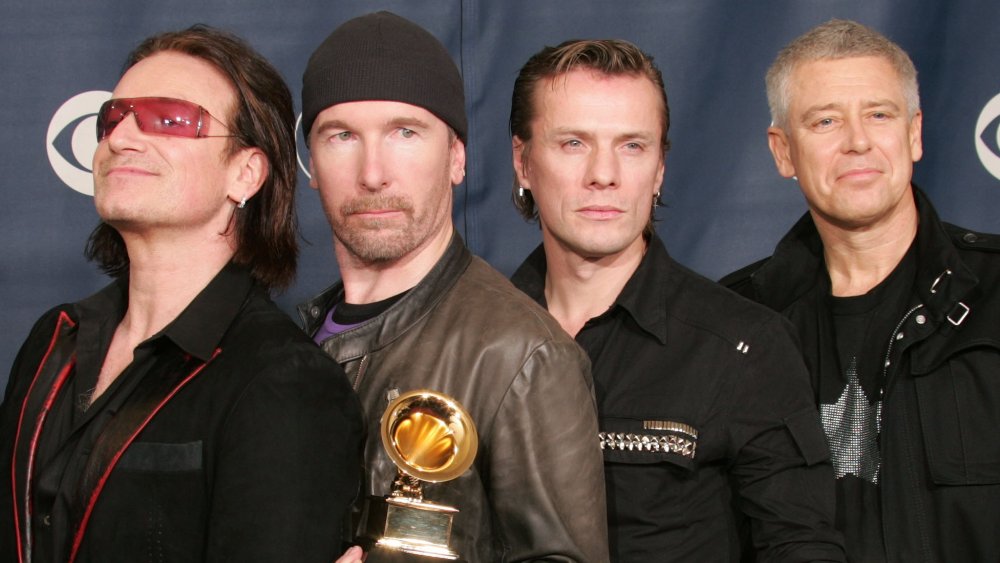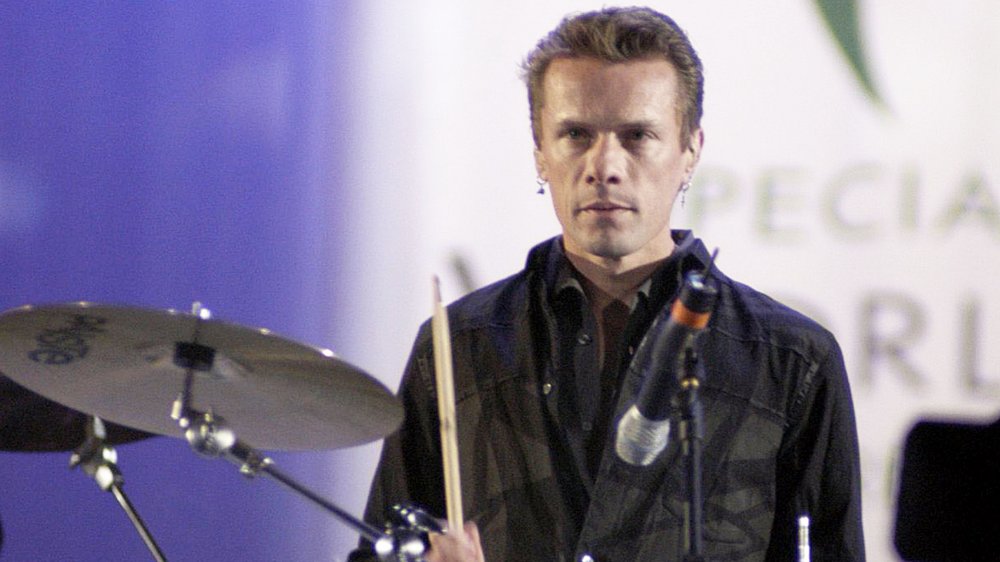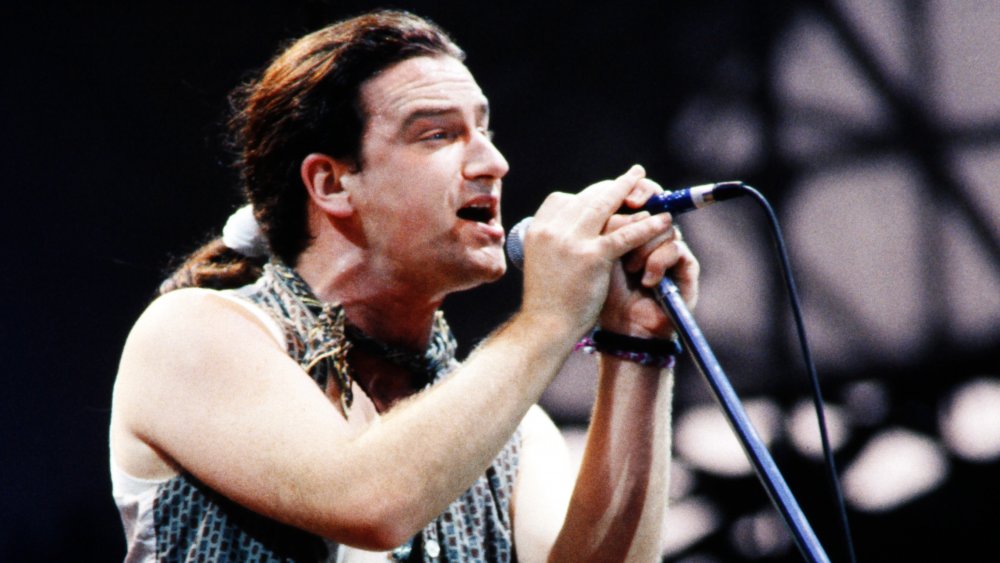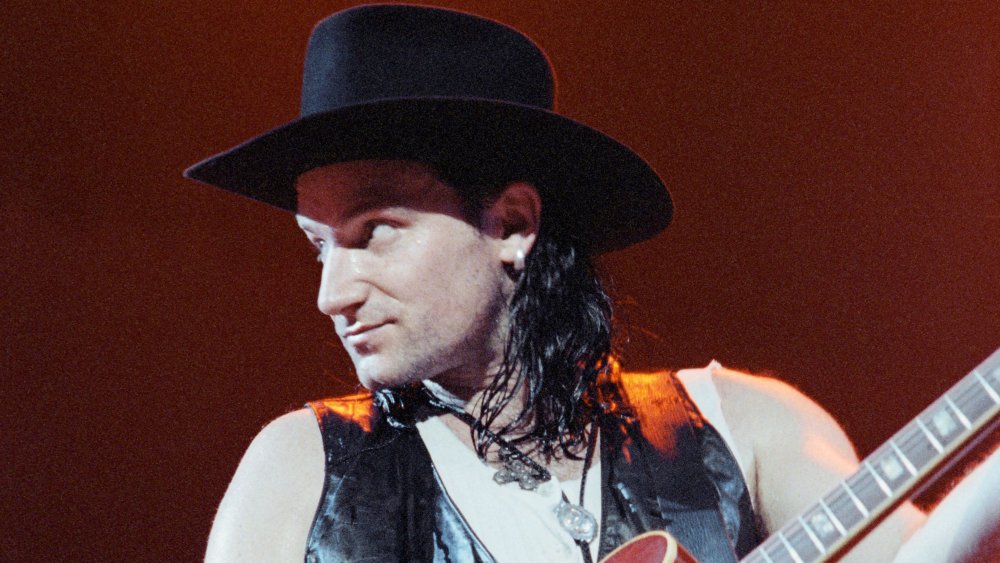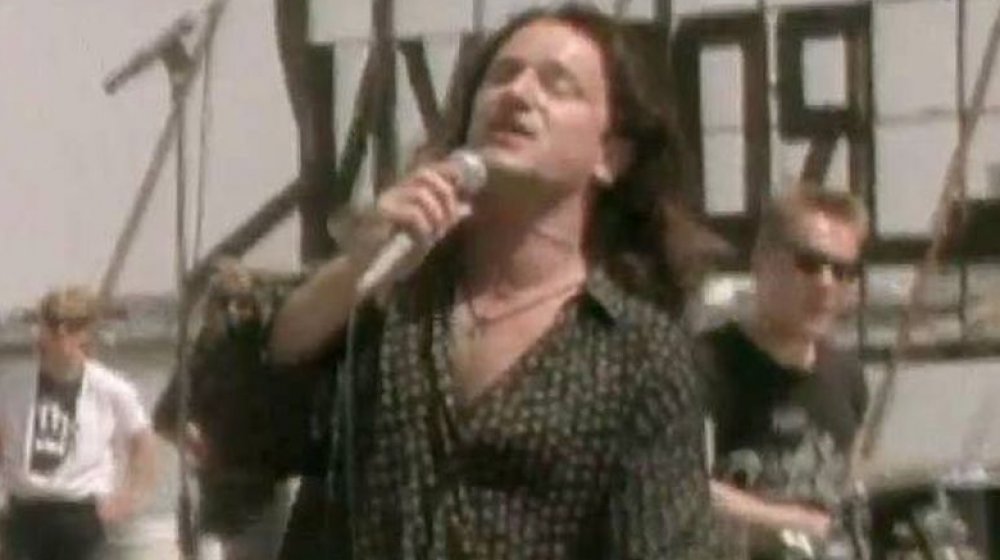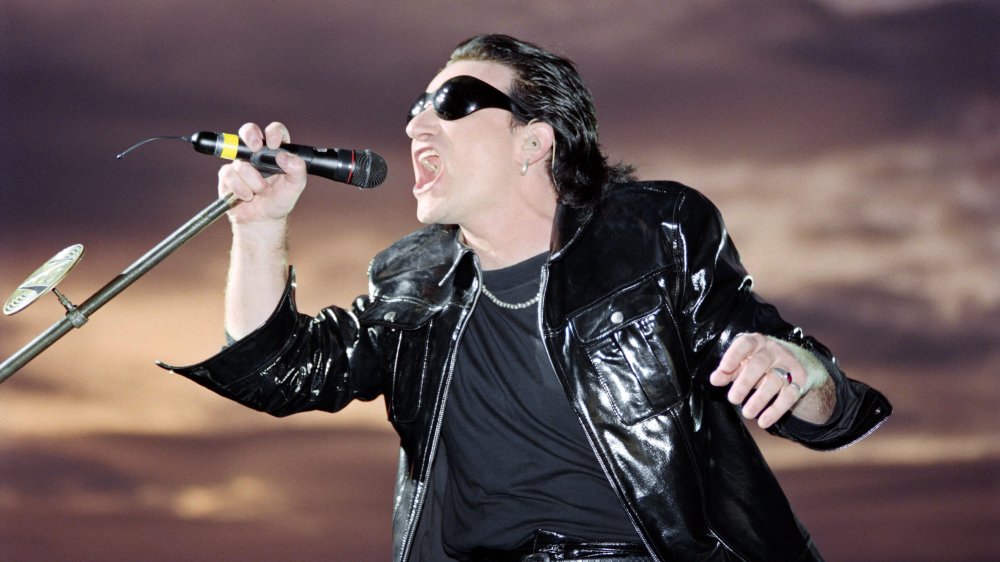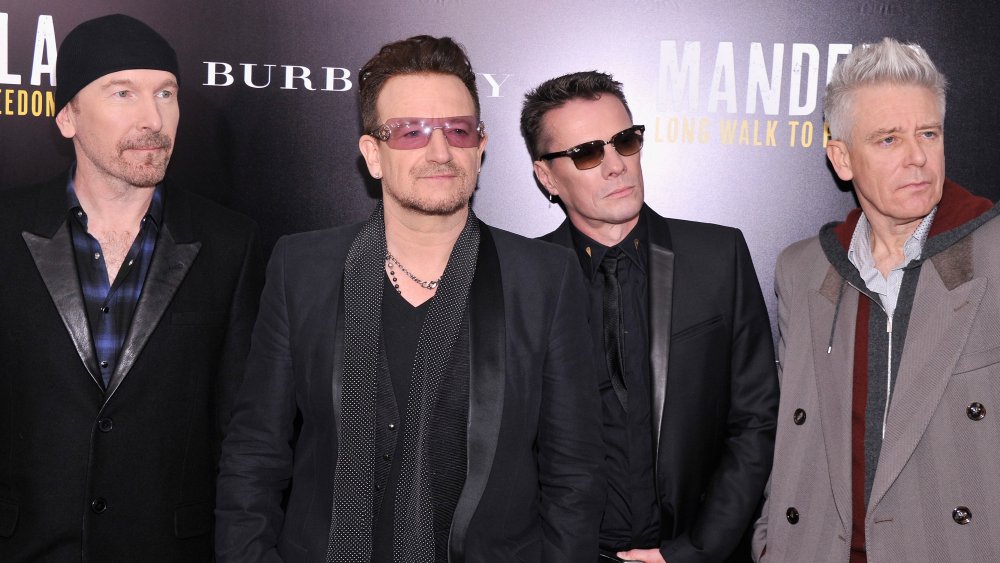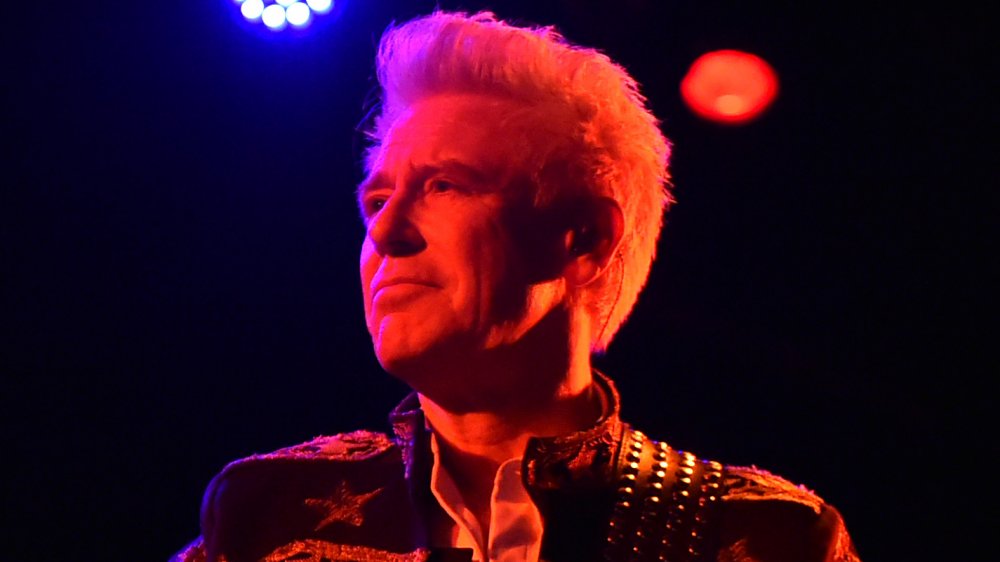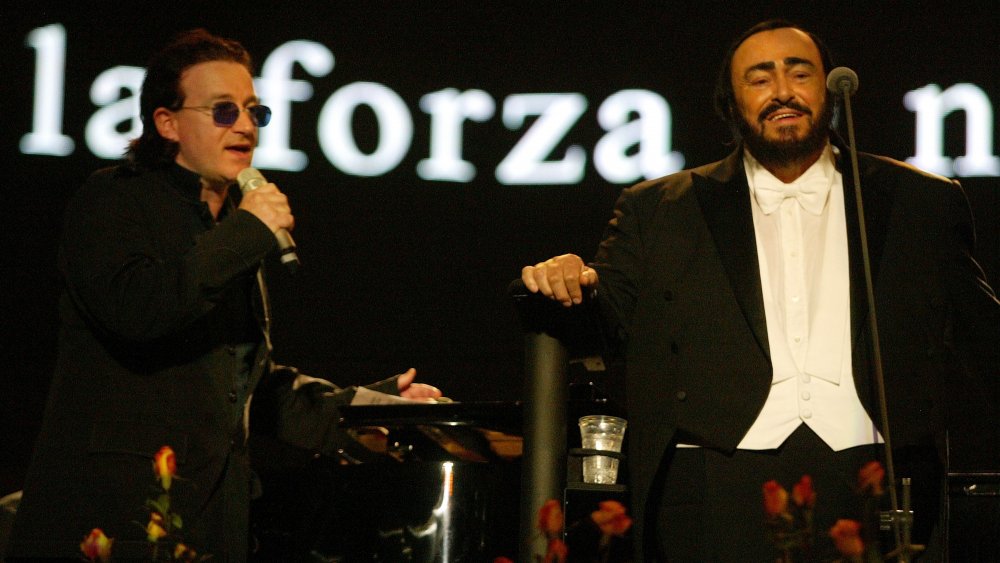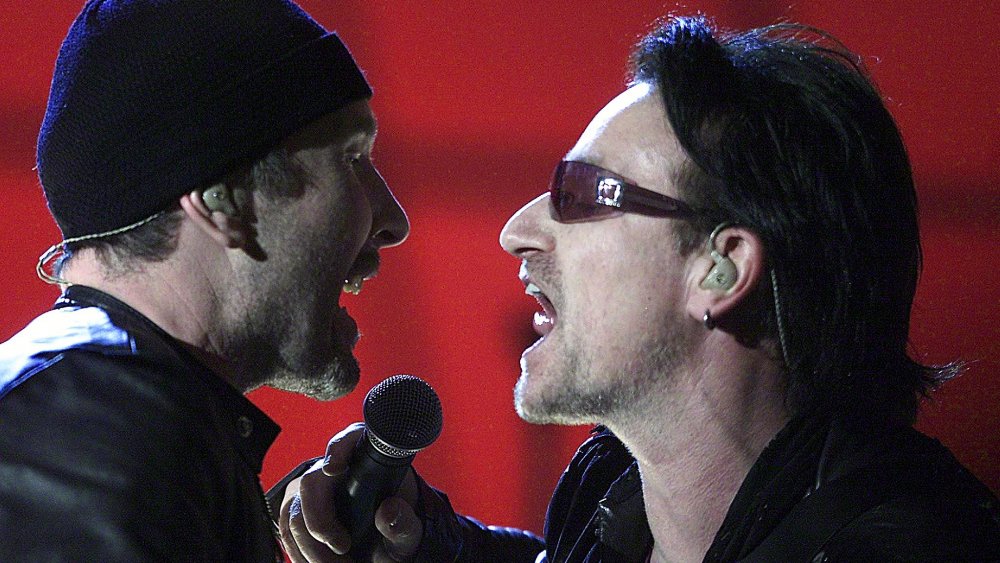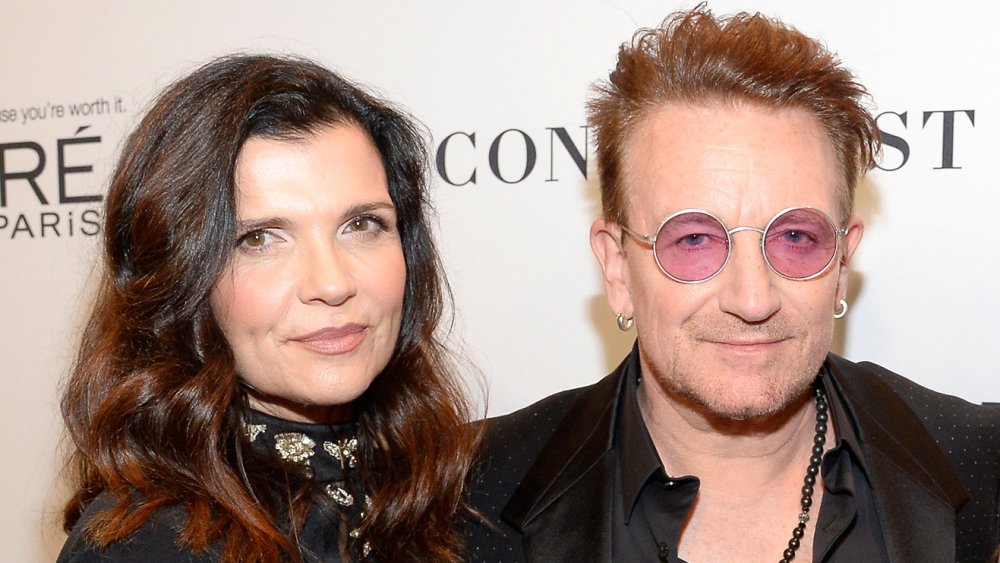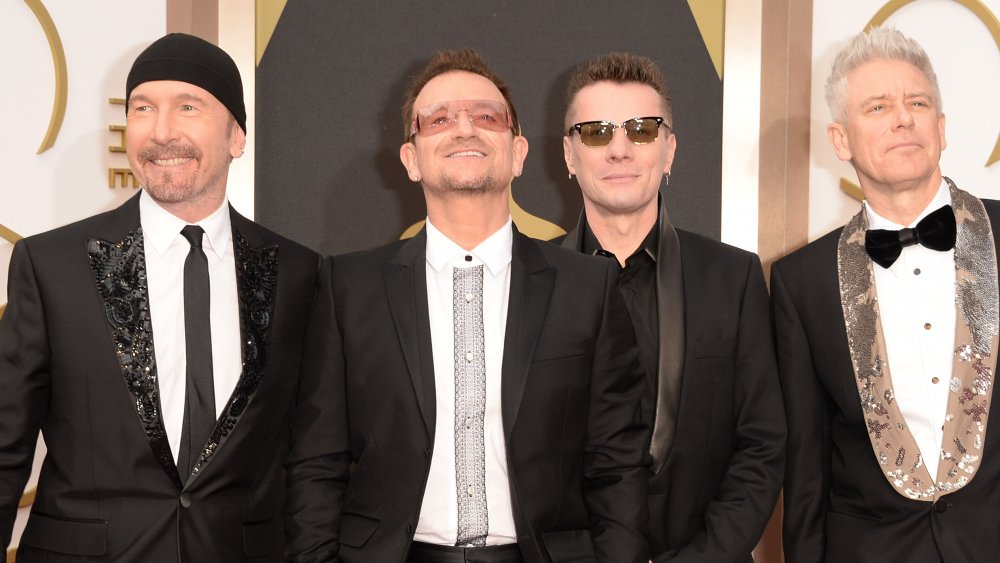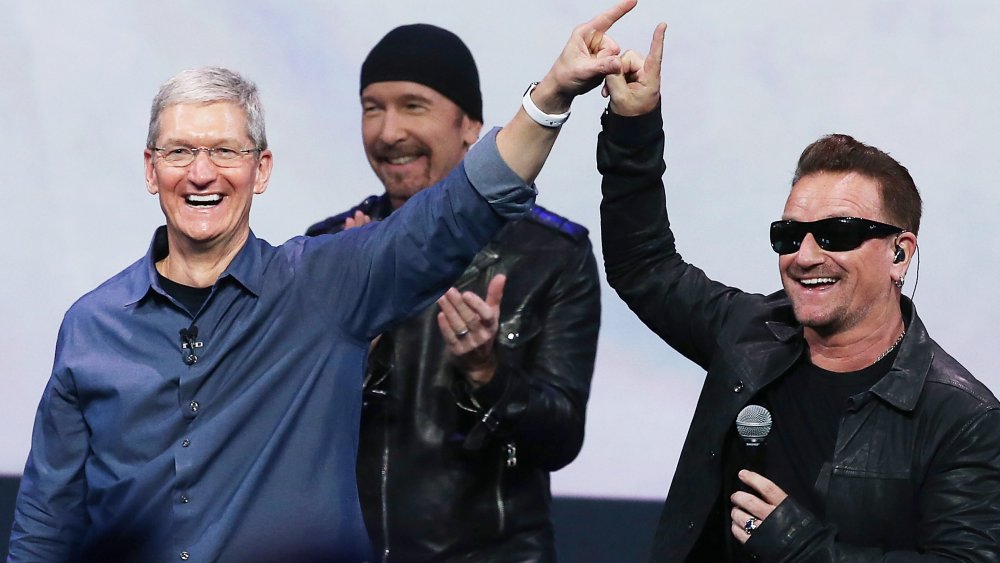The Untold Truth Of U2
Back in 1980, when U2 emerged out of Ireland with the hard-charging, post-punk single "I Will Follow," the band seemed so humble and unassuming. Little did the world know that the band would explode, both in sound and worldwide popularity, and become one of the last truly great and gigantic rock bands.
For 40 years now, U2 has churned out arena rock, alternative rock, and pop classics, from soul-crushing love songs like "With or Without You" and anthems like "Beautiful Day" to unabashedly political ragers like "Sunday Bloody Sunday." Bono has led U2 through it all, and he never would've become one of the most famous people in the world without an "Edge." The distinctive ringing, jangling, stadium-filling guitar work of the Edge matches perfectly with Bono's soulful, expressive, soaring voice. (Larry Mullen Jr. and Adam Clayton bring the propulsive rhythm and rumbling bass, respectively.)
Rock history wouldn't be the same or as interesting without U2, but there's a lot more to them than their truly fantastic songs. So today, we're doing a deep dive into the band's fascinating history. From their original name to that iPod debacle, here's the untold truth of U2, the biggest band to ever come out of Dublin.
Introducing Feedback
U2 is synonymous with Bono, but that came with time. In fact, he didn't even start the band. According to The Irish Times, in September 1976, Larry Mullen Jr. put up a note on the bulletin board at Mount Temple School in Dublin, and it read "drummer seeks musicians to form band." Not long after, Mullen auditioned potential bandmates in the kitchen of his parents' home. Guitarist David Evans (aka the Edge) showed up, followed soon by bassist Adam Clayton. Paul Hewson (later known as Bono) came also, asking to audition as a guitarist. As it turned out, he couldn't actually play that instrument, so Mullen suggested he give singing a try.
The band initially had two more guitarists. After a couple of months with the group — during which time it was known as Feedback, the Hype, and finally U2 — Ivan McCormick lost the job. When the band secured a gig at a pub, they asked McCormick to quit because he'd be too young to step foot in the place. Or at least that's what he thought. "I was very upset and cried my eyes out," McCormick told BBC News. "Then I realized they were too young to be in a pub as well, they were just letting me down in a nice way." The group's other early guitarist was Dik Evans, brother of the Edge, who quit after about a year and a half.
It took U2 a little while to break out
A big turning point for the group, still known as the Hype, came in the form of a talent competition in Limerick, Ireland, to be held on St. Patrick's Day 1978. The prize was the equivalent of about $3,100 in today's money. Just before the contest, the band realized that if they won, they "would be stuck with the Hype" as their name forever, according to Adam Clayton in U2 by U2 (via U2.com). So, the Hype became U2, and the newly christened band won the contest. Along with the cash, the band won the chance to get their stuff heard by the Irish branch of CBS Records. The label released U2's three-song EP Three, and all 1,000 copies quickly sold, and the single "Out of Control" hit #19 on the Irish pop chart.
U2 went on to play gigs in Europe, hoping to attract industry bigwigs. And it did in Island Records founder Chris Blackwell, who helped unleash luminaries like Bob Marley and Cat Stevens on the world. In 1980, he discovered U2 and signed the band, although it wasn't necessarily fully formed quite yet. "I didn't love the music," Blackwell told NPR's Weekend Edition (via The Hollywood Reporter). "It was a little rinky-dink, but I believed in them." It didn't take long to get the band into shape, because U2 released its first album Boy, later that year.
Please, call him Bono
Usually and historically, it's the rappers and DJs that have the cool and weird stage names. Not too many rock singers and guitarists face the world with a moniker other than their own. It's pretty much just the various members of the Ramones and the lead vocalist and guitar player for U2.
In the early years of the band, the singer born Paul Hewson was known as Bono Vox. (It got shortened over the years to the mononym.) That's a very mysterious, very Latin, and very cool name. It's also apt. It translates to "good voice," but interestingly, the singer picked it up from a necessary business that's not necessarily super cool — Bonavox is the name of a Dublin hearing aid company.
As far as how and why David Evans came to be known as the Edge, there's little consensus among U2 biographers and fan-site operators, and it remains shrouded in mystery. And there's no telling why the other two guys in U2 — Adam Clayton and Larry Mullen Jr. — don't have stage names at all.
The story of U2's most harrowing music video
U2 has produced a lot of memorable music videos, but "Where the Streets Have No Name" from 1987 remains a high watermark. In the video, the group plays the epic Joshua Tree single from the roof of a building in downtown Los Angeles, and the appearance of this hot-band-of-the-moment sends the city into chaos, with screaming fans, traffic jams, helicopters, and beleaguered police officers all a part of the mix before the whole thing is eventually shut down. Remarkably, everything that happened in the video is real. The band really did stop traffic one day in 1987.
If this kind of stunt sounds familiar, well, it should. Director Meiert Avis wanted U2 to emulate a famous rock 'n' roll moment. In 1969, the Beatles played together for the last time on the roof of Apple Records. While that was the end of an era, Avis figured that if U2 did the same thing, it would herald their arrival and signify the beginning of U2's time to dominate rock music (which it did, with the monster success of The Joshua Tree). "That was the album that was going to put them into the public eye," Avis told The Globe and Mail, adding that they used "a flash mob scenario to create a spontaneous media event that one couldn't help but notice."
U2 brought a Zoo
Comprising more than 150 concerts spread out over almost the entirety of 1992 and 1993, U2's Zoo TV tour was a media and entertainment overload that also served as a comment on media and entertainment overload in the age of instantaneously delivered content and information. Rolling Stone likened the Zoo TV stage set — a wall of TVs barraging the crowd with war imagery, sitcoms, and food shows — to "a postmodern art installation that reflected the numbing cacophony of the cable-TV era." Leading the charge was Bono, who performed not as himself but in the persona of an over-the-top, sunglasses-and-leather-clad rock star character named the Fly. "When I put on those glasses, anything goes. The character is just on the edge of lunacy. It's a megalomania and paranoia," Bono explained.
The singer furthered commented on current events by involving himself in them. The tour's first months went down during the run up to the 1992 U.S. presidential election, and so Bono took it upon himself to call the White House each show from the stage, asking to speak to President George H.W. Bush. The commander-in-chief never patched Bono through, but undeterred, the singer made phone calls a regular part of Zoo TV. During some shows, he ordered up pizzas for fans, and one time, he called Madonna's personal line. Like Bush, she didn't answer.
U2 nearly broke up ... twice
U2 has had the same lineup for more than 40 years, which is a remarkable rarity in rock. This isn't to say that life in U2 has been free of drama. On two separate occasions, U2 came perilously close to breaking apart. In the early 1980s, Bono, the Edge, and Larry Mullen, Jr. were all part of a religious group called the Shalom Fellowship. Just after the release of Boy, other people in the devoutly spiritual organization urged the members of U2 to end the band, arguing that a Christian life wasn't compatible with rock 'n' roll. Band manager Paul McGuinness talked Bono out of it, saying that they'd made too many commitments and that it wouldn't be very great to break those contracts.
Then in 1989 and 1990, creative differences developed in U2. Mullen, Adam Clayton, and producer Daniel Lanois wanted to stick to the band's tried and true sound, while Bono and the Edge wanted to make dance-oriented rock, inspired by English bands like the Happy Mondays and Stone Roses. Recording an album from two points of view proved difficult and unproductive, and the band was at an impasse. Then the Edge started playing a junked portion of a song — and it was magic. "It stabilized everything," Bono told Irish Times. "Everyone just sort of surrendered after we had that. By surrendering. We got over the hump." That riff became the introduction to the Achtung Baby standout "One."
How Adam Clayton's life changed after missing a U2 concert
Not only has U2 stayed intact since the late 1970s, but only once has the band played a concert without one of its founding members. In 1993, U2's Zoo TV extravaganza hit Australia. The night before a show in Sydney, bassist Adam Clayton had a couple glasses of wine around the time of a band rehearsal. What happened after that? He's not sure. "I know about three days later, I woke up, and I had not turned up for a gig, in a stadium, that was being filmed, a lot of money resting on it, a lot of jeopardy," Clayton told The Irish Post.
The musician had somehow gone on a three-day drinking spree and failed to report for U2's big Sydney show. His bass tech, Stuart Morgan, filled in for him, but Clayton was crushed. "I had let the guys down, the three guys who had stood by me since the age of 16 or 17," he said. "I let down the audience, I let down the road crew." The incident forced Clayton to take a long, hard look at his life, and make some changes. After his Sydney no-show, he quit drinking for good.
When is U2 not U2?
In 1993, U2 released Zooropa, and the group followed it with Pop in 1997. That's a very long time for one of the biggest bands in the world to go without an album. However, U2 actually did record and put out a record between Zooropa and Pop — just quietly and under a different name.
In 1995, a group called Passengers released its debut Original Soundtracks 1, featuring special guests like Luciano Pavarotti, with super-producer Brian Eno behind the controls. Who are Passengers? It's the members of U2, plus Eno, who produced The Joshua Tree. "We wanted to do a project with Brian Eno that was not a U2 album, because we had been fans of his work for a long time," the Edge said (via Ultimate Classic Rock). He added that the project was done in the name of "collaborating, songwriting, composing," while Bono said he felt like he was making "almost like a jazz record."
That wasn't the first time U2 made a side project without altering its lineup or splitting. In 1987, the band put on cowboy hats, Western shirts, and wigs, and took the stage as its own opening act, a country music combo called the Dalton Brothers (more specifically, Alton, Luke, Duke, and Betty Dalton). One highlight of their set was a cover of Hank Williams' "Lost Highway."
U2 got stuck in a lemon ... seriously
The 1984 comedy classic This is Spinal Tap details the many things that can and do go wrong for a band on tour. And one of the funniest moments comes during a performance of "Rock 'n' Roll Creation." The band's three main members emerge out of gigantic pods during the song to a cheering crowd. Well, not bassist Derek Smalls (Harry Shearer) — his pod won't open, and he's stuck in there for the entirety of the song. It's such a silly, absurd event, and a similar thing happened to U2 on its PopMart Tour.
During encores, the members of U2 would crawl out of a gigantic, spinning lemon. According to Kim Washburn's Breaking Through: The Bono Story, the lemon malfunctioned one night. Like in This is Spinal Tap, the doors wouldn't open, and Bono and the gang got stuck in the big, fake fruit for far longer than they would've liked. The amazing coda to this story is that it happened twice.
The 'Sweetest' story
In 1998, U2 scored a hit with "The Sweetest Thing." With its ringing guitars from the Edge and vocal acrobatics from Bono, it was something of a return to form for the band. After the electronic-influenced and fuzzed-out rock on its last two studio albums, Zooropa and Pop, U2 had returned to its classic, arena-filling, anthemic sound. It would also prove to be a trial balloon for U2's blockbuster 2000 album All That You Can't Leave Behind, which was packed with U2 songs that sounded like they could've come out in the '80s.
Interestingly, "The Sweetest Thing" had such an '80s sound to it because it was a relic of the '80s. It was first released in 1988 as the B-side of "Where the Streets Have No Name." U2 re-recorded the song to use as a single to promote its first greatest hits collection, along with a music video. The video features Bono sitting down a woman so he can sing this love song to her, and that's Bono's actual wife, Ali Hewson. He originally wrote the song as an apology because at the time, he was so busy in a recording studio that he missed her birthday.
The lost work of Bono
When they visited the United States on their first world tour in 1981, the members of U2 weren't super well-known, and they played mostly small clubs. And one night, U2 took their songs to the Foghorn Tavern in Portland, Oregon. Bono brought along a briefcase full of handwritten lyrics, notes, and chord progressions, most of it relating to what would be U2's next album, October. The singer left his case backstage ... and then it vanished. In the U2 book Into the Heart (via Oregon Live), band members said they suspected three women who visited backstage just before the disappearance.
Losing all that work — music that hadn't yet been experienced by the public — deeply upset Bono. When U2 returned to the studio, he had no choice but to rewrite many songs from memory, and he was already suffering creatively after a bout of writer's block. Bono eventually accepted that his briefcase was gone, although he repeatedly mentioned the event during later tour stops in Portland. And yet somehow, almost miraculously, the case — with the October materials still inside — was located in 2004, 23 years after the fact. A Portland woman named Cindy Harris discovered it in the attic of a house she'd rented way back in 1981, and it took her years to realize it belonged to Bono and that it'd been stolen. When Bono got his case back, he called its return "an act of grace."
The story behind U2's most controversial album
U2 and Apple have a long history. In 2004, the company released a special edition U2 iPod, and the band has appeared in commercials for the company's products. U2 capped it all by performing live at a 2014 Apple Event as a prelude to what Apple leader Tim Cook called "the biggest album release in the history of music." Since Bono wanted to get U2's latest album, Songs of Innocence, to "as many people as possible," Apple announced that the record would be delivered to every iTunes account in the world, all 500 million of them, for free.
It's hard to imagine the mass joy that would've resulted had U2 released a free LP in 1984 or 1994, but that's not what happened in 2014. Technology pundits and iTunes users weighed in, citing the unauthorized download of an album as a mass privacy breach. (Wired called it "devious," and Salon said the gambit briefly made U2 "the most hated band in America." An estimated 33 million people listened to Songs of Innocence within a week of its availability. Yeah, that's a lot, but it's a small fraction of the 500 million who could've check it out but decided against it.
"I'm sorry about that," Bono later said of the debacle in a Facebook event (via ABC News). "This beautiful idea, we kind of got carried away with it."
